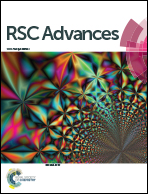Synthesis of functionalized poly(vinyl acetate) mediated by alkyne-terminated RAFT agents†
Abstract
Two new xanthates with alkyne functionalities were synthesized for the reversible addition fragmentation chain transfer (RAFT) polymerization of vinyl acetate (VAc). The new RAFT agents were fully characterized by 1H and 13C NMR spectroscopy. Unlike the alkyne terminated RAFT agent (AT-X1) the protected alkyne-terminated RAFT agent (PAT-X1) was able to conduct the RAFT polymerization of VAc with a good control over the molecular weight (MW) and relatively narrow MW distributions (Đ < 1.4). The linear evolution of Mn with conversion as well as the close agreement between Mn,th and Mn,GPC values confirmed the controlled features of the RAFT system. It is worth mentioning that the polymer dispersity remained very low (Đ < 1.20) until relatively high monomer conversions (60%) due to the non-activated nature of VAc. The chain end-functionality of the obtained polymers was evaluated by 1H NMR, FTIR-ATR and UV-Vis absorption analysis. The “livingness” of the obtained polymer was confirmed by a successful chain extension experiment. The deprotection of the alkyne functionality in the PVAc, allowed a further copper catalyzed azide–alkyne [3 + 2] dipolar cycloaddition reaction (CuAAC) with an azido terminated-poly(ethylene glycol) (PEG-N3), to afford PVAc–PEG block-copolymers as a proof-of-concept.



 Please wait while we load your content...
Please wait while we load your content...